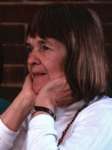|
|
||||
| Prev |
Guatemala 2000 A photo journal by David Booth |
Next | ||
|
|
||||
|
|
||||
| Prev |
Guatemala 2000 A photo journal by David Booth |
Next | ||
|
|
||||

What is this city like, the hub of a country dedicated to a decade of murder and centuries of abuse of its first people? Our first impressions were of streets filled with the ubiquitous automobile, of buses and trucks belching black diesel smoke, or horrendous traffic. Crossing streets and avenues required speed, agility and a watchful eye for no one was looking out for us. It is a city of few trees, of endless billboards and neon signs. It is a city ringed by poverty, by the uprooted and displaced who perch in cardboard shacks with corrugated roofs on the edges of ravines, unstable, close to disaster during the rainy season. It is a city whose "Central Park" is a bleak square, benchless where more men than women roam it, huddle around someone selling something. Where are the shady plazas of Mexico full of food musicians and in a timeless way? It is a city where people are very small compared to us, who walk quickly and do not smile. It is a city of few tourists where only hurry the joyless, harried people, the faceless and broken.
This was until recently, a city of fear where, unlike the countryside, the killings were clandestine, spurious. People "disappeared", their bodies tortured and turning up in vacant lots or never found again. It is a city within a country where most of its educated people have been exterminated: educators, students, labor leaders, journalists, clergy, anyone striving for justice, compassion and human rights.
We were given a tour by a young Mennonite man who has been living in the city to study human problems. He first took us to the great city dump. It is within an enormous ravine now about a third filled with garbage and landfill. Big garbage trucks thread their way to its deepest point and behind and beside them come the "dump people" carrying sticks and bags to salvage what they want and to gather what might be recycled or sold. Men, women, children, grandmothers, even toddlers thread their way up the dusty slope with bags strapped to their foreheads to bear the weight. Early in the morning the mothers rise to meet the food trucks and salvage breakfast for their families. These people are a society of the dump. Their school is the dump, their society is of the dump where elders who have worked it for years have access to the best before the others. They smell, they are social pariahs to the rest of the city. They live on the edges of the ravine in shacks that melt and fall away.
We stand safe on a viewing platform above the dust and smell. Our eyes fill with grit. At night burning fires let noxious smog hang over the city. We wish we could talk to these people, learn of their lives.
In this city live also the very small percentage of very wealthy people. We go to zone 14 where live, on the edge of the city, ambassadors, city officials, business magnates. We could have been in Los Angeles amidst the manicured gardens and modern architecture and trees. Occasional national flags wave in the breeze, and here a hired gardener clips a hedge. But no one is about. It feels that even here exists a city of dread for crime, and robbery is rife. Across the valley on another ridge are two mansions built like fortresses with walls and razor wire. Defended against robbers or against retaliation from those who suffered the deeds of the oligarchy?
Our tour ended with the city graveyard, the cemetery for the rich and powerful culminating in the tomb for the family Castilio, an important Spanish family. It is a mausoleum with the head of a sphinx up front and four Egyptian figures supporting the cement roof and a modern abstract cross at the top. We wander among trees and sections for different nationalities such as German, Chinese, English. The middle class are allowed to keep bodies there for a five year rental. They are in drawers in a cement wall. Each drawer is ringed with flowers but after five years its resident has to be withdrawn and reburied in a common grave in another part of the city.